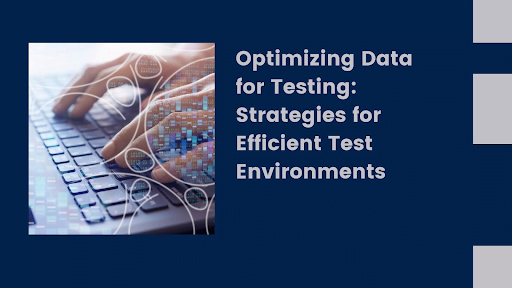Understanding how to optimize data for testing is becoming more crucial as organizations depend more and more on technology to run their operations. A summary of some of the best methods for designing a productive and affordable testing environment is provided in this article.
This blog will discuss strategies for optimizing data for testing. So let’s get started.

Understanding Test Data Management
Test data management is the process of planning, creating, storing, and managing the data used for testing software applications. It involves ensuring that the correct test data is available at the right time, in a valid format, and with the right level of quality to support effective testing. Implementing test data management best practices can improve test coverage, ensure accurate and realistic testing. The best practices for test data management are as follows:
Data Privacy and Security
- Implement data masking and data anonymization techniques to protect sensitive information.
- Ensure compliance with data privacy regulations, such as GDPR or HIPAA.
Test Data Planning
- Define clear requirements for test data, including specific data combinations and scenarios.
- Establish data dependencies and relationships to ensure accurate test coverage.
Test Data Generation
- Automate the generation of test data to increase efficiency and accuracy.
- Use tools or frameworks that can create representative and diverse data sets.
Test Data Provisioning
- Create data subsets or clones from production environments to closely replicate real-world scenarios.
- Leverage virtualization techniques to provision test data on-demand without impacting production systems.
Test Data Refresh
- Regularly refresh test data to maintain data integrity and relevancy.
- Implement data versioning to keep track of changes and rollbacks.
Test Data Governance
- Establish policies and guidelines for test data usage, access, and retention.
- Assign roles and responsibilities for managing test data across the testing team.
Test Data Reporting and Tracking
- Maintain a central repository or database to track and document test data usage.
- Generate reports to analyze data coverage, identify gaps, and monitor data quality.
Data Consistency and Validity
- Ensure data consistency across multiple testing environments.
- Validate test data for accuracy, completeness, and conformity to predefined rules.
Test Data Cleanup
- Define procedures for removing obsolete or unnecessary test data.
- Regularly clean up test environments to optimize storage and performance.
Collaboration and Communication
- Foster collaboration between testing teams, development teams, and stakeholders to align on test data requirements.
- Establish clear communication channels for sharing updates, issues, and changes related to test data.
Importance of Optimizing Data for Testing
Optimizing data for testing is essential for several reasons:
Efficiency
Optimized data reduces the time and effort required for testing. It ensures that only relevant and necessary data is used, eliminating the need to process and analyze large volumes of unnecessary data.
Test Coverage
By carefully selecting and preparing test data, you can ensure maximum coverage of different scenarios, edge cases, and business requirements. This improves the effectiveness of your testing efforts and helps identify potential issues or bugs.
Cost Reduction
Optimized data helps reduce the infrastructure and storage costs associated with managing large datasets for testing. You can optimize resource utilization and save costs by minimizing the amount of data needed and optimizing its storage.
Performance Testing
Optimizing data is crucial for performance testing, where large volumes of data can impact system performance. Using representative and realistic datasets, you can accurately simulate real-world usage scenarios and identify performance bottlenecks.
Data Integrity
Well-optimized test data ensures data integrity and consistency across different testing environments. It reduces the chances of data corruption, duplication, or conflicts that can impact the reliability and accuracy of test results.
Compliance and Security
By carefully managing and sanitizing test data, you can ensure compliance with data privacy regulations and protect sensitive information. An optimized approach helps minimize the risk of exposing confidential data during testing.
Scalability
Optimizing data allows you to scale your testing efforts effectively. It enables you to generate and provision test data quickly and efficiently, supporting agile and continuous testing practices.
Debugging and Troubleshooting
Optimized test data aids in the identification and resolution of defects. By providing focused and relevant data, isolating and debugging issues becomes easier, leading to quicker troubleshooting and resolution.
Strategies for Efficient Test Environment Management
By implementing the following strategies, organizations can optimize their:
- Test environments
- Reduce setup time
- Enhance productivity, and
- Improve the overall efficiency of their testing processes.
Here are some strategies for ensuring efficient test environments:
Environment Standardization
Establish standardized configurations for test environments, including hardware, software, operating systems, and network setups. This ensures consistency across different testing stages and reduces configuration-related issues.
Virtualization and Containerization
Utilize virtualization technologies or containerization platforms to create lightweight, isolated test environments. This allows for quick provisioning, scalability, and easy management of multiple domains.
Environment Provisioning Automation
Implement automation tools and scripts to automate the provisioning of test environments. This includes setting up the required infrastructure, installing the necessary software, and configuring network settings. Automated provisioning reduces manual errors and speeds up the environment setup process.
Environment Cloning and Snapshotting
Use the cloning or snapshot features available in virtualization platforms to create copies of existing environments. This enables the quick replication of specific configurations and settings, reducing setup time for similar environments.
Environment Monitoring
Implement monitoring tools to track test environments’ health and performance. This helps identify bottlenecks, resource constraints, or stability issues early, enabling timely resolution.
Test Data Management
Efficient test environments require well-managed and relevant test data. Implement effective test data management strategies, including data subset creation, data masking or anonymization, and data versioning.
Test Environment Clean-up
Regularly clean up and reset test environments to remove residual artifacts from previous tests. This ensures a clean and stable environment for subsequent testing and avoids any interference from the last test runs.
Collaboration and Communication
Facilitate effective communication and collaboration between development, testing, and operations teams. This helps align environment requirements, resolve issues promptly, and streamline the environment setup process.
Parallel Testing
Enable parallel execution of tests across multiple test environments. This maximizes test throughput and reduces overall test execution time.
Infrastructure as Code (IaC)
Adopt infrastructure as Code practices to define and manage test environments through code. This allows for version control, easy reproducibility, and consistent configuration management.
Final Words
Optimizing data for testing is essential for efficient test environments and effective software testing. By implementing the abovementioned strategies, organizations can ensure that their test data is properly managed, ensuring data privacy, relevancy, and integrity. They can also leverage virtualization and automation technologies to quickly provision and manage test environments, facilitating scalability and optimizing resource utilization.
Also, organizations should focus on establishing strong collaboration and communication channels between development, testing, and operations teams to ensure streamlined testing processes with minimal errors. In a nutshell, optimizing data for testing is essential for building robust, cost-effective, and reliable applications.




